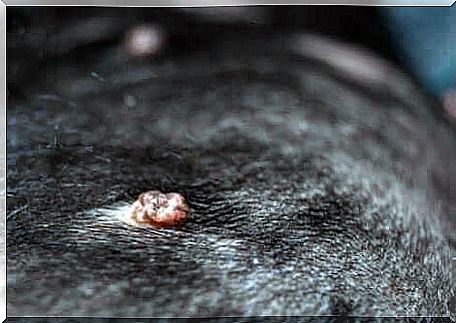Warts In Dogs: How To Prevent And Treat Them

Of all the possible skin diseases that can affect dogs, warts undoubtedly occupy one of the first places. Fortunately, even if they are very frequent, in most cases they do not pose a serious problem for the animal. Warts in dogs almost always lead to excess tissue growth that can even lead to spontaneous remission.
What is a wart?
Undoubtedly, when we hear about warts we all come to mind a similar image: that of a lump, generally small, wrinkled, the color of the skin, isolated or in the company of others.
However, this is not a valid definition from a medical point of view. We could therefore describe the wart in a simple way, saying that it is an abnormal overgrowth of epithelial tissue caused by the papilloma virus.
In this sense, technically speaking, we could define the wart as a cutaneous tumor process, considering the tumor as an abnormal growth of tissue, without necessarily being associated with a malignant component.
This type of injury can appear in dogs of any breed and condition. Nonetheless, it generally occurs more frequently in young and old animals, or in dogs that have some disorder that affects the immune system.

Why do warts appear in dogs?
Their appearance is simply due to exposure to the virus. If an animal is infected and has warts, it can transmit the pathogen directly through contact with another dog, or through surfaces, such as toys or kennels. On the other hand, there are animals on whose skin there are infectious viral particles, without having developed the warty lesion.
When the viral particles leave the original wart and “colonize” another epithelial tissue, the virus begins to replicate. A small tissue lesion occurs on the new tissue, which generates the wart. In turn, this wart returns to have a high content of infectious viral particles: as a result, the cycle begins again.
At this point, it is good to clarify that each wart is a world, and is capable of causing an infection to another dog, but also to the same dog in a different place. For this reason, it often happens that these warts do not constitute isolated processes, while, on the contrary, they lead to the appearance of various lesions on various parts of the animal’s body.
If my dog has a wart, should i worry?
Generally speaking, no. As we have said, it is a benign disorder. From a medical point of view, these are usually asymptomatic lesions, capable, in the worst case, of causing the animal only minor disturbances.
The latter circumstance occurs if the wart is located in a delicate area, such as, for example, the edge of the eyelid of the eye or the oral region.
However, to avoid possible complications, it is always advisable to contact the veterinarian at the slightest hint that the dog may be developing a lesion on the skin. Despite the benign character of warts, it is good that they are correctly evaluated, in order to confirm their benignity and differentiate them from other processes, such as mast cell tumors.

Treatment of warts in dogs
Since the immune system is involved in the development of the lesion, in most cases these are self-limiting processes. As the animal’s defenses fight the virus, the wart disappears.
However, sometimes these lesions never achieve complete remission. In these cases, always following a veterinary evaluation, surgical resection may be necessary.
This surgery is indicated for lesions that are in delicate areas or that compromise the quality of life of the animal, such as, for example, the eyes or mouth.
The procedure is generally straightforward, since major surgical approaches are not necessary, and postoperative recovery is usually immediate.
In conclusion, warts are lesions resulting from a highly contagious viral infection. Although they generally do not involve serious problems and in most cases they do not have a malignant component, it is always good for the vet to evaluate them, in order to avoid possible complications.









